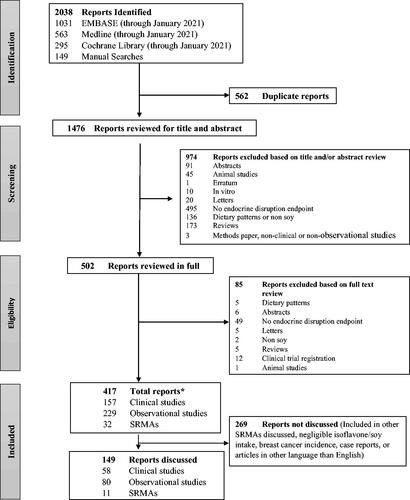Figures & data
Table 1. Isoflavone intake in infants using soy infant formula and free-living Asian children and adolescents.
Table 2. Isoflavone intake reported in large prospective epidemiologic studies from China and Japan.
Table 3. Selected examples of isoflavone exposure in intervention trials of at least approximately 2 years duration.
Table 4. Serum isoflavone levels in native Japanese adults.
Table 5. Serum isoflavone levels in men in response to varying isoflavone doses (Busby et al. Citation2002).
Table 6. Mean (SD) of serum genistein and daidzein concentrations at each visit among postmenopausal women from three medical centers in Taiwan participating in a 2-year clinical trial in which participants received either 300 mg/d isoflavones or a placebo (Tai et al. Citation2012).
Table 7. Relative binding affinity of isoflavones in comparison to estrogen (Kuiper et al. Citation1998).
Table 8. RBA of isoflavones for ERα and ERβ and comparison with E2 (Jiang et al. Citation2013).
Table 9. Search strategy.
Figure 1. Flow of the literature search and study selection. *1 report included both an SRMA and an observational study (Wei, Y.L., J. Guo, Y. Bian, Z. Gao, M. Du, H. Yang, L. Chen, Y. Zhang, X. Wang, T. Chen, J. Chen, Z. Yu, C. Huo, D. Li, L. China Kadoorie Biobank Collaborative, Group, Soy intake and breast cancer risk: a prospective study of 300,000 Chinese women and a dose-response meta-analysis. European Journal of Epidemiology, 2019. 21: p. 21.). Abbreviation: SRMA-systematic review and meta-analysis.

Table 10. Selected characteristics and results of intervention studies evaluating the effects of isoflavone exposure on breast cell proliferation.
Table 11. Amniotic fluid and umbilical cord concentrations1 (mean or geometric mean or median) of isoflavones and estrogen.
Table 12. Estrogen and isoflavone concentrations in breast milk and plasma of Korean women (Choi et al. Citation2002).
Table 13. Isoflavone concentrations (nmol/L, mean ± SD) in human breast milk samples before (day 1), during (days 3 and 6), and after (day 7) intervention with soy drink (Jochum et al. Citation2017).
